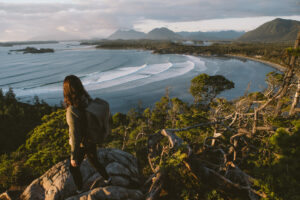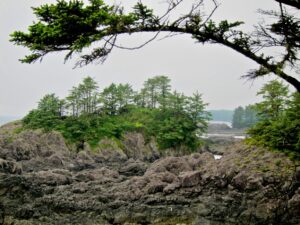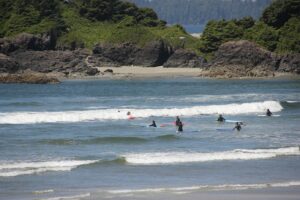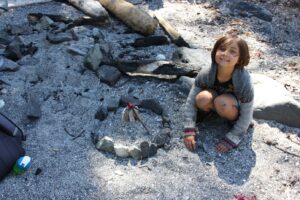When the Pacific Rim Highway connected Port Alberni to Vancouver Island’s west coast in 1959, it transformed an area previously only reachable by boat or air into an easy-to-access destination. The 126-kilometre crinkly logging road—now paved—opened all the Ukluth Peninsula’s broad beaches, intertidal zones and superb trails to worldwide visitors eager to experience the clean air and foaming waves crashing in from the open Pacific.
The first groups of visitors joining the traditional Nuu-chah-nulth and the later Norwegian, Scot and English settlers, were the hippies arriving in the 1960s. They set up makeshift dwellings on the beaches. It was the era of free love, long hair and counter-culture happenings, with riotously painted Volkswagen buses personifying the movement. Most revellers left when the heavy winter rains started, but some found local jobs or started their own enterprises.
The opening of the Pacific Rim National Park Reserve in 1971 restored the beaches to their uninhabited state; beach-camping is now prohibited everywhere. Surfers began arriving shortly afterwards, the harbingers of today’s active surf culture. Surf shops that rent wetsuits and boards abound and many waterfronts are filled with black-clad figures hoping to stay upright on a roaring surge.
The area has become an all-season destination. From late-April to mid-May, birdwatchers come to the mud flats, a key stopover for migrating birds—dowitchers, sandpipers, whimbrels and greater yellowlegs. Winter visitors come to experience North Pacific tempests that wallop into the russet-rock islands and the headlands flanking most beaches.
We went during the summer, when the weather is warmer and calmer. Approaching the junction to the 40-kilometre stretch bookended by Tofino and Ucluelet, we turned south toward Ucluelet, once a funky fishing village rife with seiners and gillnetters, now serving sport fishermen, yachties and visitors staying at upscale resorts. Our goal? To savour the string of trails and beaches along the peninsula’s coastline.
Two Wild Pacific Trail segments start in Ucluelet. I walked the first part starting at Peninsula Road. The 2.6-kilometre Lighthouse Loop circles the Ukluth Peninsula’s southern end and passes by Amphitrite Lighthouse. The lighthouse was erected after gales rammed a British 290-foot steel barque, Pass of Melfort, into Amphitrite Point on Christmas Day, 1905. In my mind’s eye, I imagined the passengers’ terror. No instruments, lights or buoys, the extreme cold, shrieking winds and jagged, vicious rocks. While I viewed those murderous stone slabs, a single sailboat ghosted between the markers.
From the trail, I checked out Terrace Beach, a gentle arch once favoured by the Nuu-chah-nulth, who fished, collected shellfish and dried and smoked their bounty here. Today, it’s a haunt for local families, the children playing with scoops and buckets or hunting for seashells. Nary a surfer in sight.
I strolled the second Wild Pacific Trail section the next day. It’s six kilometres each way, but many benches invite walkers to rest and gaze out over the crags. The muscle of wind is always evident. Seldom have I seen trees so bent and twisted by Mother Nature. A light mist lingered, and, in the distance, the lighthouse sounded its foghorn; somewhere a freighter moaned in a different key. Add to that a buoy’s clanging bell and I enjoyed a nautical concert unlike any I’ve experienced.
From this part of the trail, you can access Big Beach. It’s strewn with salt-bleached, smoothed logs and rock-filled waters not suited for surfing or kayaking, but has washrooms, picnic tables and a meadow from which to enjoy sunsets. A good family place.
Brown Beach, reachable from the 300-metre trail from Marine Drive parking, offers stupendous views of deep crevasses. There’s only a narrow inlet, yet logs have been tossed up 50 metres by the Pacific Ocean. The beach, with its large-crystal sand, is in a bowl surrounded by rocky bluffs. Completely protected from waves, it’s nirvana for kids. I met a daycare worker watching 10 children build sandcastles, make pebble gardens and play tag while clambering on rocks. Free-range youngsters.
Two kilometres south of the Tofino-Ucluelet Junction, we turned west on Willowbrae Road and entered the Pacific Rim National Park Reserve, where we paid our fee.
Willowbrae Trail splits into two paths at the 1.3-kilometre mark, leading to Half Moon Bay or Florencia Bay. The start of the trail is smooth, but the subsequent boardwalks have many up-and-down steps. We took it slow and stopped often to view the rainforest’s bounty. The boardwalk to Half Moon Bay ends in a steep step onto the smallish beach; you must also clamber over sandy, slippery logs. If you’re agile enough it’s worth it. Turning left, you’ll find abundant tidepools. It’s fun to squat and observe the variation of sea life that pulses and flutters in these shallow puddles.
Florencia Bay flanks a five-kilometre-long beach with signage warning about riptides, dangerous surf and the inaccessibility of the south end at high tide (you can also reach it the north end via Wickaninnish Road). That said, it’s a surfers’ favourite, although quieter than the more northern beaches. The bay is named after the brigantine Florencia that smashed onto the islet here in 1861—a casualty of the BC coastline known as the “graveyard of the Pacific.”
You can reach South Beach via a 1.5-kilometre round trip shoreside trail starting behind the Kwisitis Visitor Centre at the south end of Wickaninnish Beach. It’s a modest-sized beach where swimming is prohibited. A colourful totem of a bear clutching a salmon stands guard halfway on the trail. The beach’s sands are speckled by some heavy-duty volcanic boulders—from the trail above it appears as if some goddess had emptied basket full of stones onto the golden sands. Another special place.
Just north, the longest stretch of sand beckons. Rocky outcrops divide the 16-kilometre-long strand into three, Wickaninnish, Combers and Long Beach. (This distance includes the Schooner Cove beach, reachable by walking at the water’s edge at low tide.) Be sure to leave enough time to get back—it’s further by road. Several parking lots provide access to each beach and a chance to check out waves. Prevailing winds vary at each location. At very low tides, and with stamina and speed, you may be able to walk the whole distance. It has one of the best panoramic views, and at low tide, you can investigate some of the islets. The north end has outdoor showers close to the towering Incinerator Rock where the military used to burn their garbage during the Second World War. Long Beach is famous for being one of the first places in Canada where surfing took off as a sport.
At the beginning of Wickaninnish, Park Canada’s Kwisitis Visitor Centre, (turnoff at Wickaninnish Road) is housed in a silver-grey wooden building. Fittingly, Kwisitis means the “other end of the beach” in Nuu-chah-nulth. The centre, with its free entry, is well worth a visit. The museum exhibits marine and other wildlife stories, Nuu-chah-nulth history, how the Canadian Armed Forces trained here between 1942 to 1957 and the shipwrecks that led to the building of the West Coast Trail.
Leaving the centre, we wandered onto the broad beach. You can meander for minutes or hours on the hard sand. For miles, at the shore treeline, a monstrous collection of logs—that may have toppled down a mountain during a rockslide or escaped from a boom—form a jumble of silvery, tumbled wood. They may have lain here for centuries, repurposed by kids who’ve used the flotsam to build forts. Right above, the vibrant red of the Canadian flag streaming in the wind contrasted sharply with the pearly logs.
The horizon is interrupted by rocks and islets. I recommend bringing a picnic and spending the day. Disable your phone and find serenity. The surf is usually up, beachcombing is great, swimming delightful if you can stand the water’s temperature.
I spoke with a man hunkered inside a small tent among the logs. “I’m resting from the sun and might have a nap,” he said. “I’ll fold the tent later as we’re not allowed to camp.”
In the middle of Combers, three young male beach-loungers were busy carving a bong out of a bull-kelp stipe and bulb.
“A what?” I asked.
“Oh, you can drink beer out of it or smoke some sea-inspired weed,” they answered.
I rolled my eyes.
“It seems too wet and too salty,” I opined.
“Maybe, but it’s really cool to try,” they chuckled.
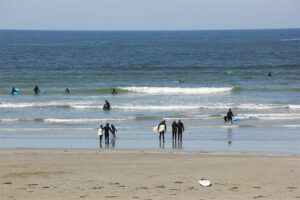
North and South Chesterman Beaches are divided by a sand spit—also called a tombolo—that, at low tide, connects to the heavily treed Frank Island. Kite- and board-surfers enjoy the two semi-circular bays, especially North Chesterman where two-and-and-half metre swells offer great rides. Other favourite activities include bocci ball, skim boarding and kite flying.
According to many, these joined beaches are the most popular. South Chesterman has tide pools and sea caves—check tides so you won’t be cut off. The beach can be accessed on foot or bicycle through the walk/bike path or by vehicle at the north end.
Mackenzie Beach, on the other hand, is calmer and ideal for families, frisbee tossing, paddleboarding and kayaking, because a series of offshore rocks and islets break the waves and protect the beach. It’s a great place to chill while the kids play. There are washrooms and showers at the Hellesen Drive access.
Tonquin Beach is especially enjoyable if you and the kids like the water a little warmer. It’s reachable on foot from Tofino. After hopping down to staircase treads incised with messages, a rainfall can create a long pond on the beach that’s degrees warmer than the ocean. It’s a great place for splashing around and building wet sand castles. Forests and seaweed-choked rocks border the semi-circular sands.
Do we have a favourite now that we’ve visited this entire string of beaches? I’ve reached no conclusions. I don’t surf, so calm beaches with tide pools entice me. North of the park, the shoreside hotels offer glowing sunsets over dinner. For families with children, Brown and Tonquin Beaches provide a natural playground with rock climbing or warm puddles.
The bottom line? Sand, sun, fresh air and breaking waves soothe our soul no matter which beach we choose.
If You Go
Info centres: Ucluelet, 250-726-4641, 1598 Peninsula Road. Tofino, 250-725-3414, 1426 Pacific Rim Highway. tofino-info.com/beaches-tofino-bc.
Accommodations range from hostels to $400-a-night luxury hotels. To find a place that fits your budget and family size, detailed listings are at tourismtofino.com.
Food
Tofino restaurants include the Common Loaf Bake Shop, Wolf in the Fog, the Kuma’s Japanese ramen, Shelter Restaurant and fish and chips at the Wild Side Grill. Food trucks often offer lower-priced fare. More at tourismtofino.com/food-drink.
In Ucluelet, you can find Norwoods, Jiggers, Taco Jefe, Hanks Untraditional BBQ and Howlers Family Restaurant with its own bowling alley, ucluelet.ca/explore-ucluelet-british-columbia/dining-restaurants-ucluelet-bc-seafood-coffee-houses-take-out-eating/restaurants/. In addition, the hotels along the northern beaches offer restaurant fare, much of it upscale.
Free Shuttle Bus
From June 30 to Labour day, Tofino offers free shuttle buses between downtown Tofino and Cox Bay with stops at the North and South Chesterman Beaches. No bikes allowed but you can bring your surfboard. tofinobus.com
Maps of the beaches can be found at: tofino-info.com/maps-for-beaches-tofino-ucluelet.
Flying into the Tofino-Long Beach Airport? Car rentals at budget.com/en/locations/ca/bc/tofino/yaz.
National Park Regs
Never approach, disturb or feed wildlife. Don’t remove or collect natural objects or cultural artifacts. No beach camping. Always leash your dog. pc.gc.ca
